

PAGE 49
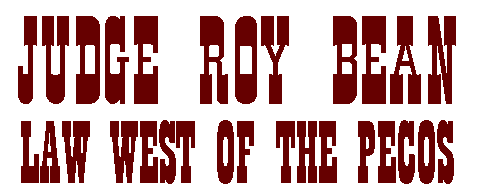
By Jerry Adams, copyright © 2001
The story of Judge Roy Bean has been told and retold many times. Judge Bean lived through some of the most formative years in American history, and experienced some of the harshest terrain, and dealt with the hardest people in the frontier west. Here we will look at the man, the myth, and the tokens related to Roy Bean. Some of what follows is truth, some is myth, the dividing line is thin. If it makes any difference, I have tried to stick to the truth where it could be found.
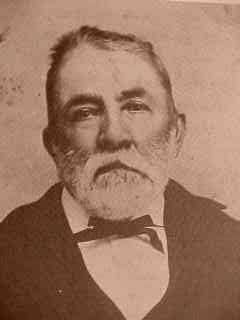
EARLY YEARS - KENTUCKY
Phantly Roy Bean was born west of Shelbyville in Shelby County, Kentucky prior to 1835 (some say as early as 1825). He was the son of Phantly R. Bean and Ann H. Bean. He had four brothers and sisters, they were: Sarah H. Bean, James C. Bean, Joshua H. Bean, and Samuel G. Bean. It is said that the name Phantly Roy, was a variant of the name Fauntleroy. The location of his birth is now a grove of locust trees.
His older brother Samuel Bean went off to fight in the Mexican war. When Samuel Bean returned from the Mexican War he only stayed a short time before he left home for good in May of 1845. Roy set off a short time later to join him, perhaps when he was between 13 and15 years of age. The two brothers got a job driving a team of six yokes of oxen in a wagon train from Independence, Missouri, through Sante Fe, New Mexico, and down to Chihuahua, Mexico.
In Chihuahua, Roy got crossways with a local badman, who hated gringos, and Roy killed him. This was a common reason for people to "move on" in the west. Roy set out for California, to find his other older brother.
SAN DIEGO and SAN GABRIEL, CALIFORNIA
Roy’s oldest brother Joshua Bean was the last alcalde (an alcalde was the mayor of a Spanish town and also a judge) of the pueblo of San Diego, and after the city was incorporated, was the first mayor in 1851.
Joshua Bean had been appointed as a Major General in the state militia. Joshua took Roy under his wing when he arrived. Roy took advantage of having a brother who was so highly regarded, and busied himself with such activities as gambling, cock fighting, horse racing and fandangos. General Joshua Bean secured for Roy a position as Lieutenant in the state militia. Roy’s appearance was described as "handsome as Adonis" with a fair and rosy complexion and silky black hair.
Unfortunately, Roy got in trouble with the law in February 1852. Roy’s pistol duel with a man named John Collins was heralded as a social event with a large crowd in attendance. Both men were evidently on horseback, and Collins fired two hasty shots at Roy who returned fire, hitting Collins in the leg with his first round, and hit his horse with the second. Both men were arraigned in Judge Ames court, being fined and jailed. A San Diego newspaper reported the events on March 27, 1852, and referred to Roy as P. R. Bean, and that was the last time Roy was ever referred to using the name Phantly, or even with the letter P. in his name. From then on it was just Roy. Roy spent just a month in jail before escaping. From there, he followed the footsteps of his brother Joshua, who had moved on to San Gabriel, just outside of Los Angeles.
Joshua had established himself as the owner of the Headquarters Saloon in San Gabriel. Unfortunately, Joshua Bean was on waylaid and killed one night on the way home from his saloon in November of 1852. Roy, who by this time had cleared up his legal problems in San Diego, inherited the saloon. Evidently Roy was relishing his roll as a saloon proprietor. This description of Roy was left by Major Horace Bell in "Reminiscences of a Ranger":
" I rode up to Headquarters and was met by a very handsome black bearded young man by the name of Roy Bean, brother and successor of General Josh Bean. The General had been proprietor of the Headquarters, the first grog shop of the place. Roy was dressed in an elegant Mexican costume, with a pair of revolvers in his belt, while a bowie knife was neatly sheathed in one of his red-topped boots."
Roy was courting with a pretty señorita about 1858, which led to either a knifing or attempted hanging, depending on which story one believes. Either way, he had to leave the area.
ROY MOVES EAST to NEW MEXICO
Meanwhile, in 1854, Roy’s brother Samuel G. Bean had been elected Sheriff of Dona Ana County, New Mexico, and was running a combination store, restaurant, gambling parlor, saloon and hotel. Sam Bean was described as a big man, with a big personality and a big voice! It is said that he acquired the big voice while bull whacking the oxen on the trail between Independence and Chihuahua. Oxen, mules and man all understood the loud voice, and the "GEE and HAW" of the bull whacker. The natives of the area called Sam’s voice the "Voz del Carretero" or Voice of the Wagon Driver.
The token:
GOOD FOR A SMILE AT / MAJESTIC SALOON / S. F. BEAN, PROP. /(encased 1905 cent) / LAS CRUCES, N. M.GO WAY BACK / AND SIT DOWN / KEEP ME & NEVER BE CAUGHT SHORT
26mmX30mm – aluminum chamberpot shaped encasement (S. F. Bean is believed to be the son of Roy Bean’s older brother Samuel G. Bean) (listed in Schilling’s New Mexico token book, 1995)
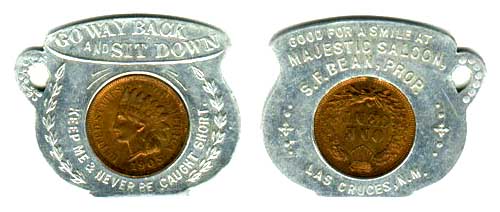
another token:
GOOD FOR ONE DRINK / AT THE / MAJESTIC / BEAN & NAVAREZ / LAS CRUCES, N.M.
GOOD FOR ONE / MORE / (screw) / IN YOUR / (coffin)Aluminum – round – 31 mm (see notes above)
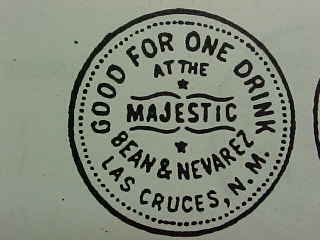

About 1860, Roy moved from California back east to Old Mesilla, New Mexico. Roy arrived broke and in rags, but Sam took his younger brother in. Samuel and Roy both operated the business, and were dealers in merchandise, liquors, and had a fine billiard table. Roy and Samuel were Confederate sympathizers. Roy organized a Confederate band called the "Free Rovers" which was known to others as "the Forty Thieves." Soon Roy called it quits, and headed for Texas.
SAN ANTONIO, TEXAS
Prior to 1865, Roy moved on to San Antonio, Texas, in order to establish a business hauling goods by wagon from Mexico, to Texas. This figured to be a money making affair, since the Texas ports were blockaded by Yankee gunboats. In San Antonio, Roy married 16 year old Virginia Chavez on October 28, 1866. Miss Chavez was the daughter of a respected San Antonio rancher named Leandro Chavez. Roy and Virginia lived on the Chavez land at what later became Beanville, where now is the four hundred block of Glenn Avenue in San Antonio. It was there that all their children were born.
The token:
BEANVILLE / GOOD FOR / 5 / CENTS / AT BAR / EXCHANGE (all incuse)(reverse has no legend)
brass – round – 24 mm diameter (estimated value : $250 )(attributed to San Antonio, Texas ) (listed in the second supplement to the TAMS Texas catalog)

Virginia bore him two daughters and two sons, before the marriage failed. Roy and Virginia Bean had the following children: Laura, Roy Jr., Sam, and Zulema. They also adopted a boy named John. Virginia Chavez Bean continued to live in San Antonio after the divorce, and married again and had other children. Roy remained single the rest of his life.
VINEGAROON, TEXAS
The name Vinegaroon, is the common name for a Whip Scorpion, scientific name of Mastigoproctus Giganteus, with a body some 3 inches long. It is solid black and has evil looking claws on the front, and a whip stinger on the rear. This rarely seen scorpion was the namesake of the tent town.
The Galveston, Harrisburg and San Antonio Railroad (also known as the Sunset Route, see transportation token Atwood-Coffee TX1000A and TX 1000L) was pushing westward from New Orleans, across western Texas, and new railroad towns were prospering. By spring of1882, Roy knew an opportunity to make lots of money lay in the railroad towns. By then, Bean was gray bearded, portly, fond of beer and whiskey. Roy Bean opened a tent saloon in Vinegaroon in 1882, and did a thriving business. Vinegaroon was rough and rowdy railroad camp. A Texas Ranger Captain named Oglesby sent this message to his commander on July 5, 1882:
"There is the worst lot of roughs, gamblers, robbers, and pickpockets, collected here I ever saw, and without the immediate presents (sic) of the state troops this class would prove a great detriment towards the completion of the road. There is nothing for Rangers to do but hold this rough element in subjection and control them. The majority of the railroad camps are in Pecos County. This immediate section being two hundred miles from Stockton, the nearest jurisdiction Court of Justice and the consequent minor offenses go unpunished but I hope to remedy that in a few days by having a Magistrate appointed for this Precinct."
Due to the outcry of citizens over the lack of law in the area, the Pecos County Commissioners court met at Fort Stockton, and passed a resolution on August 2, 1882, which said:
"…It was ordered that Roy Bean be and is hereby appointed as Justice of the Peace for Precinct No. 6, Pecos County, Texas and the Clerk of this court is instructed to notify him of his appointment, and to give the necessary Bond and qualify within the time prescribed by Law."
With that proclamation, "Old Roy" became "Your Honor Judge Bean." Roy’s appointment to J.P. was largely due to the recommendations of Texas Rangers assigned to the area. Cesario Torres was present in the courtroom when Roy was appointed, and he was the man who owned most of the land where Langtry was located. Torres and Bean were to have numerous conflicts over the next 20 years. Vinegaroon the town folded as soon as the rails pushed further west, and Roy followed the progress of the rails. His next stop was another new rail camp, named Eagle’s Nest Springs, Texas.
LANGTRY, TEXAS
The town that would become most associated with Roy Bean was first known as Eagle’s Nest Springs, and later was renamed Langtry in honor of Lily Langtry. There is some argument that the town was named after one of the railroad dignitaries, but Roy always maintained it was named for Miss Lily. On July 25, 1882, Roy Bean sent a postal card to the San Antonio Express newspaper, announcing the opening of his saloon, the card said:
"….My saloon is at the meeting point of the Great Southern Pacific and western extension of the Sunset Railway. No other saloon within a mile and a half from my place, and visitors will always find a quiet, orderly place, where they can get a good drink."For his saloon and court, Judge Bean set himself up with a 14 foot by 20-foot wooden shack, complete with bar, poker tables, and a jury box. He also had an 1879 copy of the Revised statutes of Texas, from whence he dispensed his brand of frontier justice.
Judge Bean’s saloon at Langtry was so successful, he opened a second saloon at Sanderson by October 7, 1883. It was announced in the San Antonio paper of the time, and sported billiard and pool tables, cigars, liquors, champagne beer, and whiskey. The Sanderson Bean saloon didn’t last long, as Charley Wilson who owned the Cottage Bar Saloon in Sanderson resented the Judge’s competition, and had the whiskey barrel there tainted with kerosene. Judge Bean closed the Sanderson saloon and concentrated on the Langtry operation where he had complete control.
Judge Bean ruled over Langtry for most of 20 years, first by appointment, later by election. He lost only two elections, one in 1886, the other in 1896. He lost the election in 1896 to his rival Jesus P. Torres. After counting the 100 plus ballots, it seems that the Judge had acquired more votes than there were people in the town, so the election was awarded to Torres.
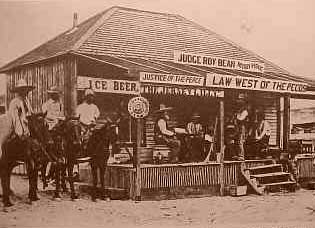
THE JERSEY LILLY SALOON
"Your Honor" Judge Bean had in his later years grown to admire and adore the English actress Lily Langtry. The popular Miss Langtry had acquired the nickname "Jersey Lily" due to her having been born on the Island of Jersey in the British Channel Islands. He hung a portrait of her in the saloon, named the saloon after her and worshiped her from afar. The Judge had a photograph of Miss Langtry cut from a magazine, and his words relating to her were "By Gobs, by ziggity, what a purty critter!"
Roy Bean’s saloon was named for Lily Langtry, but the drunken sign painter, put two ‘L’s in the name on the sign, and so it remained. From then on most folks assumed the name was the Jersey Lilly, not the Jersey Lily. In 1888, Lily Langtry made an American tour, with a stop in San Antonio; the Judge made a special trip to San Antonio, and was without a doubt the biggest admirer in the audience, the night that he set his eyes on the lady. That was the one time the Judge actually got to see the lady he had so long adored.
Judge Bean did not own the land the Jersey Lilly saloon sat on, as it was railroad land. Much of the time, he did not even have a lease on the land. At one point in 1887, the railroad tried to evict him, but they finally came to terms on a lease.Bean’s first saloon had the living quarters in the back. That saloon building burnt to the ground in 1896, but the judge built a new smaller saloon right on top of the ashes. Since his children were living with him much of the time, he built a home across the street. The judge put a sign on the front of his home and which proclaimed it was the "opera house" and bragged that he was going to have Miss Lily Langtry perform there in Langtry.
JUDGE BEAN’S PET BEAR
Roy Bean’s pet bear was chained to his iron bedpost, and displayed near his saloon, as a tourist attraction, and gimmick to sell beer. The bear loved to drink beer (don’t all bears love beer?). Evidently the bear was referred to as "the bear", whereas the Judge’s horse was named Old Bayo.
THE MAHER - FITZSIMMONS FIGHT
Roy Bean staged the Maher-Fitzsimmons fight on an island in the Rio Grande on February 21, 1896. Bob Fitzsimmons fought the Irish champion Peter Maher. Originally the fight was to have been in El Paso, but boxing was illegal in the state of Texas. The Judge was always on the lookout for something to attract customers, and the fight promoters jumped at the chance to stage the fight on the "international" island in the middle of the Rio Grande River, conveniently near Bean’s saloon. The Judge was selling beer at a dollar a bottle, and after a hot train rides from various points, most of the spectators were willing to pay the dollar for a cold beer. The fight itself lasted all of 90 seconds while Fitzsimmons pounded Maher brutally, and then knocked him out. The 21st of February 1896 proved the best day the Jersey Lilly ever had for sales.Roy voluntarily resigned his post as justice in 1902.
JUDGE BEAN’S LAW
Roy Bean’s words were often inspiring. One of the memorable quotes of the Judge, is the phrase he always ended a marriage ceremony with: "May God have mercy on your soul." Seems the Judge was observant of the human condition, as he was colorful.
My personal favorite quote from the Judge, sounds too flowery to be authentic, but perhaps it is true, perhaps not, here it is:
"You have been tried by twelve good men and true, not of your peers but as high above you as heaven is of hell, and they have said you are guilty. Time will pass and seasons will come and go. Spring with its wavin’ green grass and heaps of sweet-smellin’ flowers on every hill and in every dale. Then sultry Summer, with her shimmerin’ heat-waves on the baked horizon. And Fall, with her yeller harvest moon and the hills growin’ brown and golden under a sinkin’ sun. And finally Winter, with its bitin’, whinin’ wind, and all the land will be mantled with snow. But you won’t be here to see any of ‘em; not by a damn sight, because it’s the order of this court that you be took to the nearest tree and hanged by the neck til you’re dead, dead, dead, you olive-colored son of a billy goat."
JUDGE BEAN PASSES INTO HISTORY
"Judge" Roy Bean passed into Texas History at 3 AM, March 15, 1903. His passing at about age 70 was most likely from heart problems compounded by hard living. His remains were placed to rest in Del Rio, Texas, in the Westlawn Cemetery on March 17, 1903. He had lived through and been part of a piece of history that had seen the taming of the American west. In his defense, he was respected by most of the people who had dealings with him.
LILY LANGTRY
Lily Langtry made a trip to Langtry late in 1903, some 8 months after the Judge passed away. She visited the saloon, and saw the various tributes that the Judge had made to her over the years. The town’s folk gave her one of the Judges pistols, which she kept and put in a place of honor in her home in England.
Acknowledgements:
Thanks to NATCA member Jim Kattner for photos of his Beanville Exchange token, and Majestic Saloon token to illustrate this article.
References: Texas Siftings by Jerry Flemmons; Judge Roy Bean Country by Jack Skiles; The Handbook of Texas by Texas State Historical Society; Forts and Treasure Trails of West Texas by Joe Gibson; Pictorial History of the Wild West by James D. Horan; The Book of Texas Days by Ron Stone.
On to page 50 of token web pages...
update: 12 jan 2001